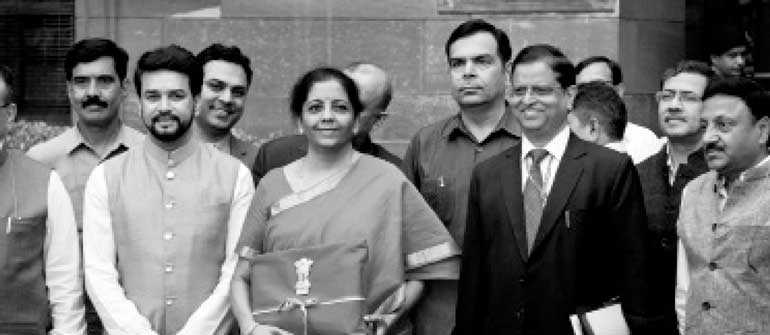Monday Mar 17, 2025
Monday Mar 17, 2025
Saturday, 6 July 2019 00:00 - - {{hitsCtrl.values.hits}}

Indian Finance Minister Nirmala Sitharaman (centre left) and junior Finance Minister Anurag Thakur (left) stand for the media outside the Finance Ministry before proceeding towards the Parliament house to unveil the annual federal budget in New Delhi
NEW DELHI (Reuters): Prime Minister Narendra Modi’s Government unveiled the budget for 2019/2020 on Friday, seeking to reverse weakening growth and investment that threaten to take the shine off a recent landslide election victory. Finance Minister Nirmala Sitharaman, presenting the annual budget statement to Parliament, said the Government planned structural reforms to kickstart foreign and domestic investment.
Modi has set a target of growing India into a $5 trillion economy by 2024/2025 from $2.7 trillion that a government report on Thursday said will be done on the back of higher investment, savings and exports in the way China’s growth was propelled.
“We need to invest heavily in infrastructure, digital economy, job creation,” Sitharaman said, adding India is set to become a $3 trillion economy in the current fiscal year.
But economists say scaling up Asia’s third largest economy in rapid fashion will need bold reforms including freeing up land and labour markets, which Modi shied away from in his first term for fear of political backlash.
Capital Economics said in a note on Friday that reaching that target “is dependent in large part on achieving real GDP growth of 8% a year, which we think is unlikely.”
Land and labour reforms are difficult in a democracy like India and it seems unlikely Modi will risk drawing the ire of his Bharatiya Janata Party voters that re-elected him with a huge mandate.
India’s economy is also running into global headwinds with growth weighed down by trade wars and protectionism.
Asia’s third largest economy grew at a much slower-than-expected 5.8% in the last quarter, the weakest growth in five years and far below the pace needed to generate jobs for the millions of young Indian’s entering the labour market each month. And the unemployment rate rose to a multi-year-high of 6.1% in the 2017/18 fiscal year.
New investments proposals in 2018/19 fell to Rs. 9.5 trillion, the lowest investment proposals recorded in 14 years, according to Centre for Monitoring Indian Economy (CMIE), a Mumbai based think tank.
Discover Kapruka, the leading online shopping platform in Sri Lanka, where you can conveniently send Gifts and Flowers to your loved ones for any event including Valentine ’s Day. Explore a wide range of popular Shopping Categories on Kapruka, including Toys, Groceries, Electronics, Birthday Cakes, Fruits, Chocolates, Flower Bouquets, Clothing, Watches, Lingerie, Gift Sets and Jewellery. Also if you’re interested in selling with Kapruka, Partner Central by Kapruka is the best solution to start with. Moreover, through Kapruka Global Shop, you can also enjoy the convenience of purchasing products from renowned platforms like Amazon and eBay and have them delivered to Sri Lanka.
Discover Kapruka, the leading online shopping platform in Sri Lanka, where you can conveniently send Gifts and Flowers to your loved ones for any event including Valentine ’s Day. Explore a wide range of popular Shopping Categories on Kapruka, including Toys, Groceries, Electronics, Birthday Cakes, Fruits, Chocolates, Flower Bouquets, Clothing, Watches, Lingerie, Gift Sets and Jewellery. Also if you’re interested in selling with Kapruka, Partner Central by Kapruka is the best solution to start with. Moreover, through Kapruka Global Shop, you can also enjoy the convenience of purchasing products from renowned platforms like Amazon and eBay and have them delivered to Sri Lanka.